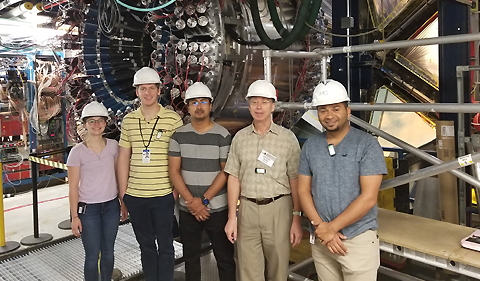
L to R: Ohio University students Miranda Carver, Joseph Rowley, Utsav Shrestha, Dr. Kenneth Hicks, and Taya Chetry in front of the CLAS12 detector at Jefferson National Laboratory
By Miranda Carver
(B.S. Astrophysics, College of Arts & Sciences, Class of 2020)
The meson is a particle made from one quark and one antiquark. The strong force between quarks allows mesons with different masses to exist, each with unique quantum numbers. The f1(1285) meson has a mass of 1285 MeV and has a total spin of J=1. It is produced at Jefferson National Laboratory by directing a beam of photons with energies of a few GeV onto a proton target. The decay products of the f1(1285) are then measured in the CLAS detector.
To do this research with Dr. Kenneth Hicks, a professor in Physics & Astronomy, I used a specialized software for data analysis. Root is a computer program used by particle physicists. It is primarily written using C++ language. I learned how to write programs with Root by starting with a simple decay. A Lambda particle will decay in two dimensions going to a pi minus and proton. I calculated the angle of decay from the Lambda momentum. I wrote a separate program to find the invariant mass using Lorentz vectors. Finally, I made two more programs for this particle decay but in three dimensions.
Using the CLAS Detector I was able to read data in and run data files through skims in order to study the physics behind the particle reaction I was investigating. I learned how to access all the data files from Jefferson Lab’s interactive farm (the server at Jefferson Lab in which we are able to access the CPU resources), and then how to use the CPU farm to run files through skims. For different channels of decays, we use different skims. Skims allow us to look at the variables we are interested in based on what research we’re doing.
After executing the skims for all the files, I investigated certain channels of the decay. The channels I investigated are: when the f1(1285) meson particle is created and decays into two final states: and . The analysis on the angular distribution of the f1(1285) decay compared to phase space, and compared to theoretical models of this decay is in progress and will be investigated further.
What fascinated me most about my project is how far we have come since bubble chambers in the field of particle physics. The advancement of technology for detecting particles with such precision itself is a wonderful feat.



















Comments